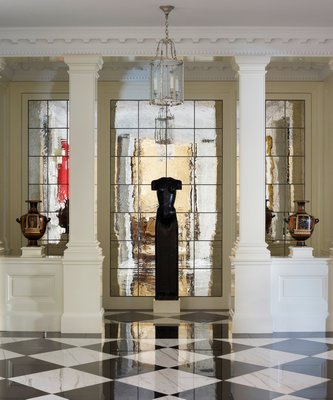
As we mature, the mirror may not be the favored spot upon which to alight our eyes. But as an architectural and decorative tool, mirror is indispensable. Used as an architectural tool, mirror doubles spatial perception within a space. Mirror doubles the light as well, drawing precious brightness into dull spaces.
This does not mean one should advocate wholesale sheets of the stuff glued to every surface. But when used judiciously and discreetly, mirror amplifies as it expands. For instance, a dark room with small windows piercing deep walls provide an opportunity to line the frames of the deeply set windows with quietly inset planks of mirror that actually swell the view outside while inviting more light inside.
A typical brownstone in Manhattan or Brooklyn possesses cased windows flanking a rather narrow strip of wall. By applying mirror to the casing, an enlarged view of the room will result. If you place curtains on the windows, the mirror in between seemingly disappears and the room appears magically larger. (A trick the Victorians used with pier mirrors.)
In a long, dark, narrow room with two small windows facing a spectacular view, I had to mirror the opposite dark wall to give architectural width to the room. By carefully placing the expansive sheets within architectural casings and exposing no seams on the mirror, I was able to convey the desired volume. But what truly hid the mirrored acreage was the simple act of hanging a painting on the mirror. When paintings, mirrors, barometers, sculptures and furnishings are placed on or in front of the mirror, it loses its tacky glitz and bows to its best property—expansiveness.
And as a landscape device in a small garden, mirror is invaluable. Placed at the end of an alley of hydrangeas and framed by a trellised arch, you will have doubled your mop head blooms. Though you should remember architectural framing allows the mirror to act almost as a doorway into another garden.
I’ve known friends who slip mirror in between their fence posts and allow their perennials to climb blowsily in front—once again doubling their abundance while complementing the gardener’s prowess. Unfortunately, robins, not the brightest in the aviary, tend to attack their own reflections—sometimes till they dash themselves to death!
Decorative mirrors obviously have their utilitarian side, standing guard over our aging reflections, but they also fulfill the need to inhabit wall space that might otherwise be occupied by art. To my way of thinking, if the art you covet for over your sofa is unaffordable or your art is too diminutive to fill the space, a large decorative mirror is an excellent alternative and quite sensitive to the pocketbook.
The habit of leaning gargantuan mirrors on a large blank wall was once ever so chic and quite casually and effortlessly used in dress salons. But it might be overused a bit now and should they fall on a friend because they aren’t properly adhered to the wall—things might get a bit messy!
I have to admit to a bit of an addiction to mirrors and found my basement piling up with inherited pieces and flea market finds that I couldn’t resist. So in a large, unassuming hallway with little natural light, I hung all of them—gallery style—or hodge-podge as some might say—mixing in a few small, valuable paintings here and there. It turned out to be rather effective. I also remembered that this “gallery” style hanging of decorative mirrors looks quite smashing running up the walls of darkened stairwells too.
One last note is a reminder that there are countless varieties of mirror: from hand blown to poured, to tinted blue, pink, green, yellow and black, to crackled, to smoked—and of course antiqued. But do remember, once you buy an antiqued mirror, it continues to age and after many years will darken.
So it seems, magic need not have smoke, but it must have mirrors.